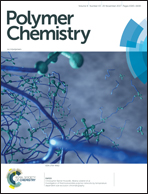Silyl-based initiators for two-photon polymerization: from facile synthesis to quantitative structure–activity relationship analysis†
Abstract
Exploring new initiation functionalities is critical for the design of efficient photoinitiators applied in two-photon polymerization. In this paper, we present a facile and effective synthesis strategy to construct silyl-based two-photon initiators (2PIs) containing nitro groups as electron acceptors, alkylamines as electron donors and double bonds as conjugation bridges. Steady-state absorption, time-resolved fluorescence, and ns-transient absorption were employed to quantitatively investigate the photo-physics and -chemistry of the 2PIs. The results showed that the photophysical and photochemical behavior of these 2PIs is marginally affected by the introduction of a silyl group, but strongly depends on solvent polarity. The nonlinear absorption spectra over a broad spectral range were determined via two-photon-induced fluorescence, revealing maximum two-photon cross sections of ∼90 GM. In two-photon polymerization structuring tests, the 2PIs can be employed to build fine 3D microstructures with a resolution of ∼280 nm. The acrylate formulations containing novel 2PIs exhibit a comparable threshold energy and ideal processing windows as commercial photoresists IP-L, which have been specifically designed for Nanoscribe's laser lithography systems.



 Please wait while we load your content...
Please wait while we load your content...